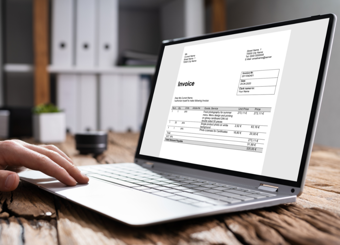Why AP professionals should take a spend transparency approach towards accounts payable
The concept of spend analysis has been around for over two decades. It started with the classical “spend cube” in Excel, which many consulting firms used as a foundation for crafting the cost out programs they sold to CFOs and CPOs. Then it developed further, with more advanced spend analytics tools and technology to help AP professionals. In the last few years, the rapid increase of automation in the invoice management process, coupled with d technology including machine learning, has revolutionized how companies can capture detailed spend data, even on non-PO invoices.
The business case for advanced spend management and analysis is clear: Aberdeen research shows that businesses can achieve up to a 20% savings for each new dollar of spend brought under management and maintain a 73% rate of contract compliance with spend analytics best practices in place. And Ardent Partners’ research shows that with a superior level of spend visibility, the average Best-in-Class procurement organization reports higher levels of annual savings (6.3% vs. 6.1%) and 47% better contract compliance rates than the other groups in the market (66% vs. 45%).
No surprise, then, that in a recent survey conducted by IHS Markit, which polled 340 supply chain leaders across 60 countries and 33 industries, 70% indicated that spend analytics was the top priority for their business. However, 63% of survey respondents also noted that they lacked the technology necessary to properly capture and analyze their spend data, thereby hampering their ability to make cost-saving decisions.
Perhaps this recognition of the need for more advanced technology is the reason for Gartner’s prediction that “By 2022, 50% of all legacy spend analysis software will be retired; replaced by artificial intelligence (AI)-powered, cloud-based solutions.”
Many names for the same concept
To better appreciate why spend analysis is so important, though, we need to have a more thorough understanding of what the term means. Throughout the years the same basic concept has been re-packaged, re-named, and re-marketed following trends around “big data”, “analytics”, and “digital”. A common definition is hard to find, but when Spend Matters asked Lora Cecere of AMR research (acquired by Gartner), she suggested a definition that summarizes the key components of spend analytics.
Her definition: "A collection of best practices in management of 'spend' data, (i.e. data related to sourcing and procurement) leveraging software tools built around core data classification and enrichment technologies. This enables delivery of enterprise spend visibility to ensure compliance and control... The benefits include the ability to analyze the impact of sourcing strategies on key categories, along with assessments of business results (savings), and measurement of KPIs (periodic review of compliance with preferred suppliers and contracts, savings realized etc.) along with ongoing control of spend for improved profitability."
In short: Spend analytics is the process of turning invoice data to meaningful insights that lead to increased savings and spend management. The process can be described in five main steps.
Create a spend category tree. The category tree spans across geographies, cost centers, functions, and any organizational belongings or responsibilities. Within indirect spend, the purchasing categories can be created from standards such as, for example, UNSPSC. The scope of direct material varies considerably between different industries; thus a more tailored approach towards defining the category tree may be needed.
Identify, extract, and import data. Extract spend data from the accounts payable ledger in the ERP system, or directly from the invoice management system. The data should at least include every invoice or invoice row, with associated information about the supplier, date, total, currency, account, and cost center. However, all information is good information when AP professionals want to draw insights from the data. With a best-in-class automated accounts payable process that captures all information on the invoice, down to the line item level, the effort in this and the two following steps in the process is considerably lower.
Data cleansing. The third step involves cleaning, correcting, and normalizing data - for example, managing errors in the supplier list and grouping duplicates, or misspelled item or supplier names.
Categorize purchases to the category tree. Once all the data is in the same format, the fourth step is to categorize the AP data. Start the categorization on the account level. For example, certain GL accounts can be mapped with their entire spend into certain categories. Next, analyze the suppliers. Since the category tree is constructed based on how the supply market is organized, the majority of the suppliers will fit into one or a few categories. This means that the vast majority of categorization can be done by defining which category each supplier should belong to. Be aware of cases where the supplier needs to be divided between more categories.
As you can see from the steps above, spend analytics is an involved process with many moving parts. That’s why investing in an automated solution that breaks down these steps and manages them for you is so advantageous to your business - not only does it save you valuable time and resources, but it also dramatically decreases the margin for error, ensuring that your data is reliable.
Before there is insight, there is data
Having spend visibility and using it to achieve a business advantage are two different things. The value of spend analysis is not the data itself, but in the ways that the data is leveraged to inform the decisions that drive greater value and improve performance. Thus the fifth and final step is to analyze, conclude and implement actions.
There is a set of standard analysis that should be done in every category - from contract compliance to volume bundling and internal benchmarking. A.T. Kearney’s book ”The Purchasing Chessboard” is considered by many as a go-to publication for the levers to apply depending on the insights from spend analysis. Here are actions to implement once spend transparency is achieved.
Reduce maverick purchasing. Spend analysis reveals how often available contracts, negotiated for the best prices and terms, are not being used. This is true, especially in the case of indirect spend.
Rationalize supplier base: Bundle volume to more suppliers and negotiate volume discounts.
Manage tail spend. Suppliers that add up to 20% of total spend is an area usually referred to as the tail spend. Capture and AP automation software play a crucial role as the analysis of the tail spend often requires the use of all available information captured in invoices. Streamline, consolidate, and monitor low-value areas of spending to reduce ad-hoc spend transactions, such as purchases made on low-volume items off-contract, rush orders, or special projects.
Benchmark performance against market development. Are your raw material and logistics costs following the market indices? Benchmark internal performance. Are you paying the same price for different items in different geographies?
Optimize working capital. This is one of the quick wins that you can take through robust spend analysis. Identifying categories and suppliers with lower-than-policy-level payment terms provides a great starting point for freeing working capital.
If the benefits are so great, why are they so difficult to achieve?
There are several reasons why spend visibility is difficult to achieve. Purchasing data often sits in disparate systems, ERP, supplier databases, procurement systems, and invoice management systems. Simply bringing all of it together to analyze in one place is a challenge. Hence, the market and need for specialized spend analysis and management tools.
With a best-in-class automated AP process, companies can ease or even bypass this challenge. The invoices you normally receive includes all the fields of information needed to get to spend transparency, so why the need for information from other systems? The answer is that you need capture software invoice management best practices to ensure that the AP department can capture all the details of the information on the invoice, down to the line item level.
It’s not unusual for companies to build the business case for AP automation on reducing invoice processing times and increasing operational efficiencies. This may lead to implementing sub-optimal best practices in the AP process. One example of this is capturing invoice information on the header level and not on the line item level. Some time might be saved in processing the invoice, but the opportunity is lost to capture data that can later be used as leverage in the procurement process.
Spend analysis re-imagined for the future
Imagine if your invoice management process, in addition to processing the invoice, also classified each purchase to purchasing categories and agreements. The business intelligence gained by spend transparency would be a direct outcome of the AP process through standard reporting, without the need for specific spend analysis technology.
Now, re-imagine step four above if your invoice management process utilizes templates and machine learning to classify spending on certain GL accounts and supplier IDs directly in connection to the processing of the invoice. The solution will not only be able to classify the data, but also interpret it to identify trends and recommend actions. This is the spend analysis of the future.






